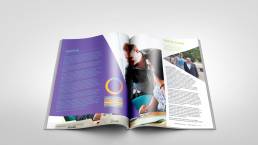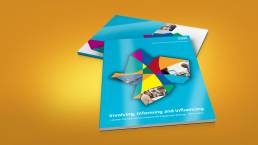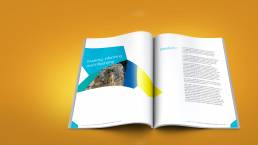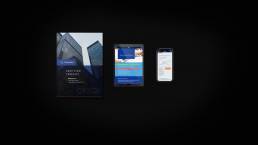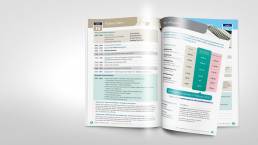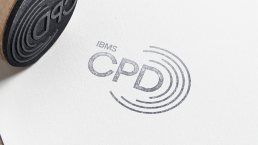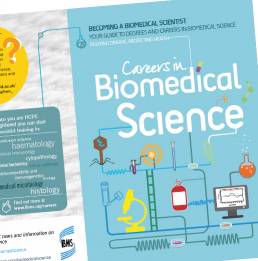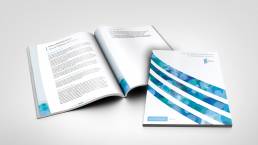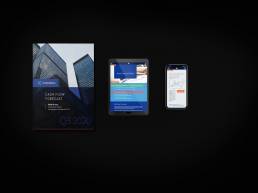05 Finish and format
The texture of paper, foil print effect or emboss all help to portray your brand and message.
When you have reached your final hurdle, the fifth and last step is just as if not the important step, this is where all the attention to detail should be rewarded. Whether you chose to only produce a digital report, a plain printed report or a report that has a mix of finishes, prints and glosses this is where the hard work comes together. The result is always up to the client and below I have outline just some of the options available.
Paper type
There are many options for paper style and thickness, the feel of your annual report is important and different textures and thickness will reflect a certain type of quality. Whichever option you go for just remember to go with a thick paper stock for the front and back cover at least so that you can define the cover pages from the content.
Paper size
A4 seems to be the most popular size for most annual reports designs, there have been clients in the past that have gone smaller or bigger but again this depends on you the client, your organisation and your audience.
Binding or stitching
The options for binding or stitching are limitless, with new and creative options popping up all the time. Below I have outlined some of the most popular ones:
Comb Binding – Comb binding has been around for over 40 years it is popular because the plastic binding allows the book to open flat to make pages easy to read.
Coil Binding – Same as comb binding but a single piece of spiralled metal or plastic is wound through the edges of a book, creating a final product that is sturdy and looks presentable. Spiral coil binding is much more robust than comb binding and looks great on presentations and proposals.
Saddle-Stitching – Saddle-stitching where loose-leaf papers are secured down the middle of the booklet with staples. Saddle-stitching is a cost-effective way to bind smaller, less formal materials.
Velo Binding – Velo binding is essentially the opposite of comb binding or coil binding. 11 small holes are punched along the edge of an unbound book. Two rigid pieces of plastic are placed along the spine on the front and back of the book with tines connecting the pieces and holding the book together.
Perfect Binding– Perfect binding is the kind of binding you see on paperback books. This type of binding is great for both books and presentations alike. It involves binding the pages together with adhesive glue along the spine.
Screw Fixing – This is a good option for smaller annual reports, holes are drilled into the pages of the annual report and screws are inserted.
Other options to consider:
- Case binding
- String binding
- Sewn binding.
Finishes
Varnishes (machine/gloss/matt/silk/UV)
Much like a wood varnish, print varnishes add an extra protective layer over the paper stock. The varnish is applied after the printing process, but before the cutting and binding of sheets. Varnishes can not only give a different sheen to the outer layer of paper but also different textures too.
Lamination (Gloss/Matt/Satin)
Lamination is like a thin layer of plastic, which is often used on the covers of printed items to add both decorative and protective values. It may not always be visible but it is easily identifiable to the touch as it creates smooth and water-resistant finish.
Embossing and Debossing
Embossing and debossing are similar finishes, where the surface is either raised or pressed into the page. This process brings a three-dimensional appeal to printed items and looks impressive on the dividers and cover pages of an annual report.
Letterpress
Letterpress is the oldest form of printing and is used for decorative and vintage effects, the process involves a block template of raised letters that is inked up and pressed onto the paper surface, recreating the letters in reverse.
Die Cutting
Die cutting is a technique of cutting out shapes from stock that is used in packaging designs or business cards with rounded corners. It can be produced using a steel-edged which is fed through a printing press. This is another technique that can be used for the cover pages of a report.
Foil Stamping/Blocking
Foiling is one of the most popular and luxury finishing techniques, a metallic foil is applied with pressure to the stock using heated metal die and a hot foiling stamping machine. The finished effect creates a smooth and shiny surface, you can also get matt foils. Another great technique for cover pages, dividers, contents pages or special sections within a report.
Holographic Foils, Pearlescent and Iridescent Inks
Holographic Foils similar to foil stamping can be used to add a stylish reflective effect to your cover design. Pearlescent and Iridescent are also another great technique for cover pages as they give a rainbow-like colour and sheen to the final finish.
Edge Painting
Painted edges refers to a finishing process where the sides of a piece of print are covered with a layer of ink or paint. This looks great on a report as it would make the pages of the cover stand out from the content pages.
Would you like a premium look and feel report created without the cost?
Recent Projects


